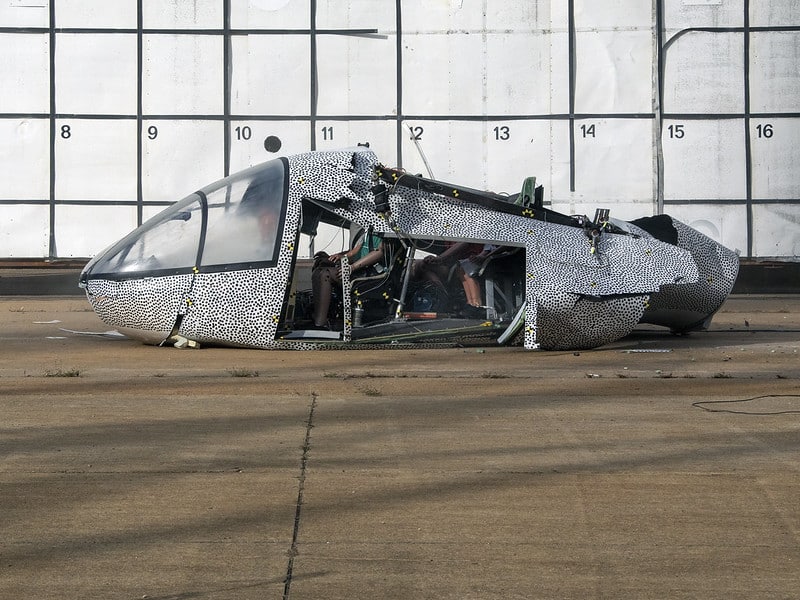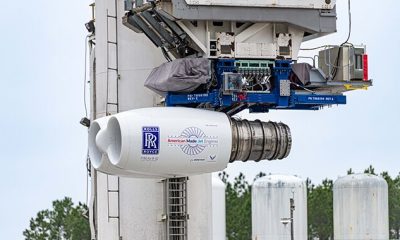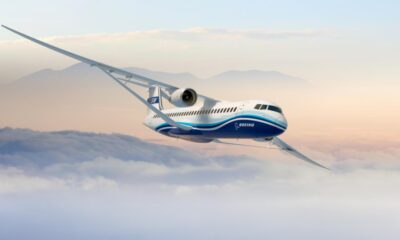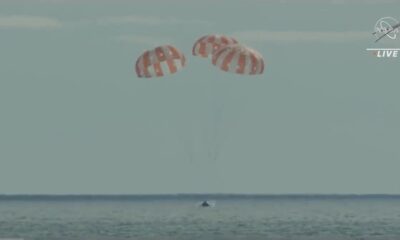Aerospace
NASA Crash Tests eVTOL Concept
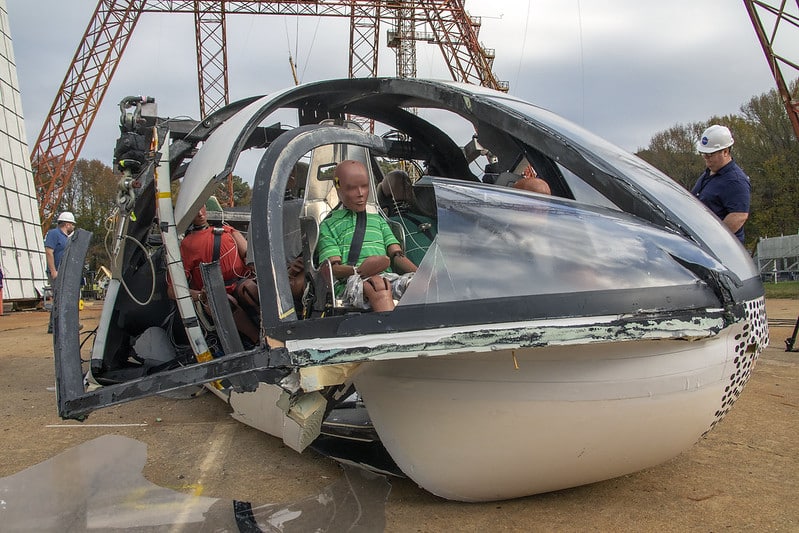
NASA researchers recently completed a full-scale crash test of an electric vertical takeoff and landing (eVTOL) concept vehicle at the Landing and Impact Research (LandIR) facility at NASA’s Langley Research Center in Hampton, Virginia.
The eVTOL was a ‘Lift+Cruise’ test article developed by the Revolutionary Vertical Left Technology (RVLT) project in another effort for NASA to advance research for the Advanced Air Mobility (AAM) mission.
NASA Orders Three More Orion Spacecraft From Lockheed Martin(Opens in a new browser tab)
NASA’s vision for AAM is to help emerging aviation markets safely develop an air transportation system that moves people and cargo between places previously not served or underserved by aviation. Understanding how these future aircraft may act in a crash scenario is another key point of research. Hoisted into the air, then released with pyrotechnic cutters, the model swung forward and down back to the Earth with a loud crash.
A variety of experiments were included on the test article. These experiments included several seat configurations including a NASA energy absorbing concept, various sizes of crash test dummies to study the effects of the crash loads on all sizes of occupants, and a modular NASA-developed energy-absorbing composite subfloor.
9 years child applies for a job at NASA here is how NASA replied(Opens in a new browser tab)
The first event was the floor crushing and seat stroking. The subfloor and energy absorbing seats functioned as intended and limited the effect of the impact on the crash test dummies. The second was the collapse of the overhead structure. The effect of the overhead structure collapse on the crash test dummies is still being determined.
For this test, an overhead-mass was designed to represent the wing structure, rotor and battery. The decision was made to assume that all the weight of the overhead structure was over the cabin. There are many other overhead-mass configurations which may behave differently in a crash.
More #eVTOL crash test footage! This was from recent testing at @NASA_Langley. Details: https://t.co/LydMHhxaYr
?️: Gary Banziger pic.twitter.com/Jdy7iMUf17
— Elan Head @[email protected] (@elanhead) December 20, 2022
The test data will be used to refine modeling techniques and reported to the AAM community so that it can be discussed. The full-scale testing data will be used to improve the simulation models such that in the future, the predictions will be more realistic. The data will further be used as the basis for evaluating potential test conditions and configurations that will be used during a drop test of a second Lift+Cruise test article, tentatively scheduled for testing in late 2023.

Aerospace
Indigo will soon launch Air Taxi Service in India

InterGlobe Enterprises, the parent brand of IndiGo, is set to revolutionize travel in India with its upcoming air taxi service.
Scheduled for a potential launch in 2026, this innovative venture promises a seamless journey for passengers between two bustling hubs. Delhi and Gurgaon in Haryana. The forthcoming service is projected to revolutionize the daily commute, offering passengers a swift aerial journey covering the distance in a mere 7 minutes.
This remarkable efficiency contrasts starkly with the conventional 90-minute drive, underscoring the immense time-saving potential for commuters. The anticipated fare, ranging from Rs 2,000-3,000, makes this innovative mode of transport not only swift but also remarkably competitive in pricing.
At the heart of this ambitious endeavor lies a strategic partnership with Archer Aviation, a pioneer in electric vertical takeoff and landing (eVTOL) aircraft technology. Under this collaboration, Archer will supply 200 state-of-the-art eVTOL aircraft, representing an investment of US$ 1 billion. These cutting-edge aircraft, capable of accommodating up to four passengers alongside the pilot, epitomize the future of sustainable air travel.
Powered by six battery packs, Archer’s eVTOL aircraft boast rapid charging capabilities, enabling a swift turnaround between flights. With a charging time of just 30-40 minutes, these eco-friendly aircraft ensure minimal downtime, maximizing operational efficiency.
Similar services are anticipated to be introduced by the joint venture in Bengaluru and Mumbai as well. Nevertheless, the service rollout period has not yet been made public by the company. Next year, it is anticipated to get its certification. Following this, the company will start the certification procedure with the Directorate General of Civil Aviation (DGCA).
Aerospace
Which is bigger 777x or 787 aircraft ?

The 777X is a new series of the Boeing 777 family and is designed to be larger and more efficient than its predecessor. It features two variants: the 777-8 and the 777-9, being the larger of the two.
The Boeing 777X emerges as the larger sibling within the Boeing family, representing a significant leap forward in both size and efficiency. Comprising two variants, the 777-8 and the 777-9, the latter takes the crown as the larger of the two. With its expansive fuselage and impressive wingspan, the 777X is tailored for long-range journeys and boasts a substantial passenger capacity.
On the other hand, the Boeing 787, affectionately known as the Dreamliner, occupies a niche in the market as a smaller yet formidable aircraft designed for medium to long-range flights. Its distinguishing feature lies in its composite fuselage, a technological marvel that renders it lighter and more fuel-efficient compared to conventional aluminum counterparts. The Boeing 777X is larger than the Boeing 787 aircraft.
When it comes to passenger capacity, the 777-9 reigns supreme, typically accommodating a sizeable contingent of 400-425 passengers in its standard configuration. In contrast, the 787, with its more modest dimensions, typically carries between 240-290 passengers, depending on the variant and layout.
One of the remarkable innovations introduced with the 777X is its folding wingtips, a feature designed to address the logistical challenges of accommodating such a large aircraft in conventional airport gates. These folding wingtips enable the 777X to retract its wings, allowing it to fit into gates designed for smaller aircraft while still reaping the benefits of an extended wingspan during flight, thereby enhancing fuel efficiency and operational flexibility
Aerospace
China Secures Production Certificate for Mass Production of Pilotless eVTOL Aircraft

The first passenger-carrying pilotless electric vertical takeoff and landing (eVTOL) aircraft in the world, the EH216-S, has received the Production Certificate for its eVTOL aircraft from the Civil Aviation Administration of China (CAAC).
This is a significant milestone for EHang Holdings Limited, the leading UAM technology platform company in the world. This outstanding accomplishment is another big step towards mass manufacturing for the eVTOL aircraft and the ensuing commercial operations, building on the ground-breaking acquisition of the Type Certificate and the Standard Airworthiness Certificate for the EH216-S.
The PC is a crucial certificate that the aircraft maker receives from the CAAC, the country’s aviation authority. By obtaining this certificate, EHang has demonstrated that it has set up a quality management system for mass production that satisfies the airworthiness regulation standards set forth by the CAAC, and the company has been given permission to continue producing mass quantities.
It is also a strong guarantee of the calibre of the goods made by EHang. Raw materials, supplier management, manufacturing organisation, production quality control, aircraft pre-delivery test, after-sales repair and maintenance, etc. are all included in the mass production quality management system for the EH216-S.
To ensure that every aircraft and its components that roll off the production line strictly adhere to the approved type design and safety requirements, the system sets clear guidelines and documentation for every step in the production procedure. This ensures comprehensive traceability and safety control.

